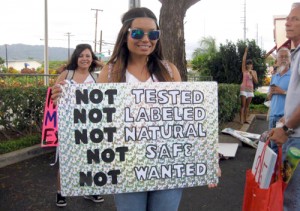
05 Apr EARTH MATTERS: HAWAII REJECTS MONSANTO GMO

Hawaiians protest Monsanto
In the 1960’s, the Green Revolution transformed the landscape of large-scale agriculture by increasing production around the world. Armed with technology transfer initiatives, the Green Revolution marked the roots of a “neo-colonial” system of commercial agriculture and a decline of subsistence agriculture. The goal of the Green Revolution was to save billions of people from starving. That would be accomplished through the development of high-yielding varieties of crops via the distribution of hybridized seeds in conjunction with an intensive use of synthetic fertilizers made from petroleum and expanded use of toxic pesticides and herbicides such as Roundup, manufactured by Monsanto.
The Green Revolution was well-intended, but history has shown that the implementation of the technology required intensive water use and saturated arable land with toxic chemicals. In addition, the intensity of pesticides harmful to human health had be increased over time as insects adapted to the chemicals. In short, the Green Revolution resulted in the degradation of the world’s arable land. Yet today, Monsanto has revised the destructive ideology of the Green Revolution with the development of genetically modified organisms (GMO) for large-scale agriculture.
As in the past, Monsanto claims that the implementation of GMO technology will increase food production and save billions of lives. However, the untold Monsanto truth has more dubious connotations.
Similar to the negative impacts caused by the technologies of the Green Revolution, GMOs also require intensive use of water, synthetic fertilizers, and toxic pesticides that degrade the quality of arable land and water systems. Making matters worse, Monsanto has patent rights to the technology and seeds, which means that a corporation that exists to generate profits for its stockholders can hold farmers captive. In addition, if GMO seedlings migrate to non-GMO crops via wind, courts in the U.S. have ruled that since Monsanto owns the intellectual rights to GMOs, the newly transformed crops belong to Monsanto, and the farmer owes Monsanto compensation for “using” them. On top of that, recent research has indicated that long-term human consumption of GMOs may significantly increase the potential of cancerous tumors and organ failure.
As with the Green Revolution, the development of Monsanto GMOs is occurring on isolated islands like the archipelago of Hawai’i. The company chooses to develop GMOs on islands because they are off the radar screen of mainstream media. (The thought is the propagation of GMOs could be contained if the experiments went awry.)
 Currently, Monsanto operates about 8,000 acres in Hawai’i for GMO seed production on the islands’ most valuable agricultural land. Moreover, Hawai’i has become a global center for open-air field-testing of GMO crops. Consequently, arable land on many of the islands in the state of Hawai’i has been degraded and the existing GMO crops threaten to eliminate sustainable methods of traditional agriculture.
Currently, Monsanto operates about 8,000 acres in Hawai’i for GMO seed production on the islands’ most valuable agricultural land. Moreover, Hawai’i has become a global center for open-air field-testing of GMO crops. Consequently, arable land on many of the islands in the state of Hawai’i has been degraded and the existing GMO crops threaten to eliminate sustainable methods of traditional agriculture.
Fortunately, concerned Hawaiians have joined a global movement to eradicate GMO experiments from the islands. Following the path of Europe, Hungary, Bhutan, and others, Hawaiians have collectively begun a movement to stop Monsanto from destroying their environment, threatening human health, and denying their freedom of choice.
Recently, statewide protests involving thousands of people have challenged the validity of Monsanto’s GMO experiments, bringing the crisis to mainstream public attention. As a result of the protests, many Monsanto operations have been disrupted and the company decided to move all Monsanto GMO experiments off the island of Kauai.
Hopefully, the efforts of Hawaiians will help prevent our global society from making the same mistakes previous generations made and will foster locally grown, natural, non-toxic food sources for present and future generations.


Sorry, the comment form is closed at this time.